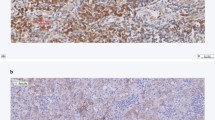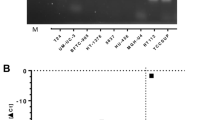Abstract
Objective
The aim of this study was to examine the expression patterns of CEACAM5 in prostatic non-neoplastic and neoplastic lesions and further investigate its relationship with tumor microvessel density(MVD) and lymphatic vessel density(LVD).
Methods
CEACAM5 expression was detected using immunohistochemical staining in a serial sections of the benign prostatic hyperplasia (BPH), prostate intraepithelial neoplasia (PIN) and prostate carcinoma (PCa) lesions. MVD and LVD were quantified in CEACAM5 positive areas by dual-labelling with CD34 and D2-40 respectively.
Results
Both PIN and PCa had significantly higher expression for CEACAM5 than BPH which has no positive expression for CEACAM5(P<0.05). In PIN and PCa, CEACAM5 staining showed different expression patterns in terms the of most of membranous staining for PIN, less membranous staining and more cytoplasmic staining for PCa. MVD results showed that PCa and PIN had more angiogenesis than BPH tissue. The value of MVD in PCa tissue was correlated with tumor Gleason grading (P<0.05). LVD results showed that neoplastic lesions had more lymphangiogenesis than non-neoplastic lesion.
Conclusion
CEACAM5 had different expression patterns in prostatic non-neoplastic and neoplastic lesions, and these various expression patterns may be correlated with tumor progression through promoting tumorous angiogenesis or lymphangiogenesis.
Similar content being viewed by others
References
Gold P, Freedman SO. Specific carcinoembryonic antigens of the human digestive system. J Exp Med. 1965 Sep 1;122(3):467–481
Taheri M, Saragovi U, Fuks A, Makkerh J, Mort J, Stanners CP. Self recognition in the Ig superfamily. Identification of precise subdomains in carcinoembryonic antigen required for intercellular adhesion. J Biol Chem. 2000 Sep 1;275(35):26935–26943
Ordonez C, Screaton RA, Ilantzis C, Stanners CP. Human carcinoembryonic antigen functions as a general inhibitor of anoikis. Cancer Res. 2000 Jul 1;60(13):3419–3424
Ilantzis C, DeMarte L, Screaton RA, Stanners CP. Deregulated expression of the human tumor marker CEA and CEA family member CEACAM6 disrupts tissue architecture and blocks colonocyte differentiation. Neoplasia. 2002 Mar–Apr;4(2):151–163
Chan CH, Cook D, Stanners CP. Increased colon tumor susceptibility in azoxymethane treated CEABAC transgenic mice. Carcinogenesis. 2006 Sep;27(9):1909–1916
Chan CH, Camacho-Leal P, Stanners CP. Colorectal hyperplasia and dysplasia due to human carcinoembryonic antigen (CEA) family memberexpression in transgenic mice. PLoS One. 2007 Dec 26;2(12):e1353
Hostetter RB, Campbell DE, Chi KF, Kerckhoff S, Cleary KR, Ullrich S, Thomas P, Jessup JM. Carcinoembryonic antigen enhances metastatic potential of human colorectal carcinoma. Arch Surg. 1990 Mar;125(3):300–304
Hashino J, Fukuda Y, Oikawa S, Nakazato H, Nakanishi T. Metastatic potential of human colorectal carcinoma SW1222 cells transfected with cDNA encoding carcinoembryonic antigen. Clin Exp Metastasis. 1994 Jul;12(4):324–328
Zareba P, Zhang J, Yilmaz A, Trpkov K. The impact of the 2005 International Society of Urological Pathology (ISUP) consensus on Gleason grading in contemporary practice. Histopathology. 2009 Oct;55(4):384–391
Weidner N, Folkman J, Pozza F, Bevilacqua P, Allred EN, Moore DH, Meli S, Gasparini G. Tumor angiogenesis: a new significant and independent prognostic indicator in early-stage breast carcinoma. J Natl Cancer Inst. 1992 Dec 16;84(24):1875–1887
Ferro M, Bruzzese D, Perdonà S, Mazzarella C, Marino A, Sorrentino A, Di Carlo A, Autorino R, Di Lorenzo G, Buonerba C, Altieri V, Mariano A, Macchia V, Terracciano D. Predicting prostate biopsy outcome: prostate health index (phi) and prostate cancer antigen 3 (PCA3) are useful biomarkers. Clin Chim Acta. 2012 Aug 16;413(15–16):1274–1278
Terracciano D, Bruzzese D, Ferro M, Mazzarella C, Di Lorenzo G, Altieri V, Mariano A, Macchia V, Di Carlo A. Preoperative insulin-like growth factor-binding protein-3 (IGFBP-3) blood level predicts gleason sum upgrading. Prostate. 2012 Jan;72(1):100–107
Duxbury MS, Matros E, Clancy T, Bailey G, Doff M, Zinner MJ, Ashley SW, Maitra A, Redston M, Whang EE. CEACAM6 is a novel biomarker in pancreatic adenocarcinoma and PanIN lesions. Ann Surg. 2005 Mar;241(3):491–496
Glinsky GV. Anti-adhesion cancer therapy. Cancer Metastasis Rev. 1998 Jun;17(2):177–185
Kraus AC, Ferber I, Bachmann SO, Specht H, Wimmel A, Gross MW, Schlegel J, Suske G, Schuermann M. In vitro chemo- and radio-resistance in small cell lung cancer correlates with cell adhesion and constitutive activation of AKT and MAP kinase pathways. Oncogene. 2002 Dec 12;21(57):8683–8695
Zhou H, Stanners CP, Fuks A. Specificity of anticarcinoembryonic antigen monoclonal antibodies and their effects on CEA-mediated adhesion. Cancer Res. 1993 Aug 15;53(16):3817–3822
Duxbury MS, Ito H, Benoit E, Waseem T, Ashley SW, Whang EE. A novel role for carcinoembryonic antigen-related cell adhesion molecule 6 as a determinant of gemcitabine chemoresistance in pancreatic adenocarcinoma cells. Cancer Res. 2004 Jun 1;64(11):3987–3993
Yoshioka T, Masuko T, Kotanagi H, Aizawa O, Saito Y, Nakazato H, Koyama K, Hashimoto Y. Homotypic adhesion through carcinoembryonic antigen plays a role in hepatic metastasis development. Jpn J Cancer Res. 1998 Feb;89(2):177–185
Thomas P, Gangopadhyay A, Steele G Jr, Andrews C, Nakazato H, Oikawa S, Jessup JM. The effect of transfection of the CEA gene on the metastatic behavior of the human colorectal cancer cell line MIP-101. Cancer Lett. 1995 May 25;92(1):59–66
Charbonneau J, Stanners CP. Role of carbohydrate structures in CEA-mediated intercellular adhesion. Cell Adhes Commun. 1999;7(3):233–244
Benchimol S, Fuks A, Jothy S, Beauchemin N, Shirota K, Stanners CP. Carcinoembryonic antigen, a human tumor marker, functions as a intercellular adhesion molecule. Cell. 1989 Apr 21;57(2):327–334
Oikawa S, Inuzuka C, Kuroki M, Matsuoka Y, Kosaki G, Nakazato H. Cell adhesion activity of non-specific cross-reacting antigen(NCA) and carcinoembryonic antigen (CEA) expressed on CHO cell surface: homophilic and heterophilic adhesion. Biochem Biophys Res Commun. 1989 Oct 16;164(1):39–45
Briganti A, Larcher A, Abdollah F, Capitanio U, Gallina A, Suardi N, Bianchi M, Sun M, Freschi M, Salonia A, Karakiewicz PI, Rigatti P, Montorsi F. Updated nomogram predicting lymph node invasion in patients with prostate cancer undergoing extended pelvic lymph node dissection: the essential importance of percentage of positive cores. Eur Urol. 2012 Mar;61(3):480–487
Yamamura T, Tsukikawa S, Yamada K, Yamaguchi S. Morphologic analysis of microvessels in colorectal tumors with respect to the formation of liver metastases. J Surg Oncol. 2001 Dec;78(4):259–264
Yoshida Y, Kurokawa T, Fukuno N, Nishikawa Y, Kamitani N, Kotsuji F. Markers of apoptosis and angiogenesis indicate that carcinomatous components play an important role in the malignant behavior of uterine carcinosarcoma. Hum Pathol. 2000 Dec;31(12):1448–1454
Jebreel A, England J, Bedford K, Murphy J, Karsai L, Atkin S. Vascular endothelial growth factor (VEGF), VEGF receptors expression and microvascular density in benign and malignant thyroid diseases. Int J Exp Pathol. 2007 Aug;88(4):271–217
Garcia EA, Simões K, Wakamatsu A, Ressio RA, Alves VA, Longatto-Filho A, Camargo RS. Lymphatic vessel density and VEGF-C expression are significantly different among benign and malignant thyroid lesions. Endocr Pathol. 2010 Jun;21(2):101–107
Cheng L, Bishop E, Zhou H, Maclennan GT, Lopez-Beltran A, Zhang S, Badve S, Baldridge LA, Montironi R. Lymphatic vessel density in radical prostatectomy specimens. Hum Pathol. 2008 Apr;39(4):610–615
Trojan L, Michel MS, Rensch F, Jackson DG, Alken P, Grobholz R. Lymph and blood vessel architecture in benign and malignant prostatic tissue: lack of lymphangiogenesis in prostate carcinoma assessed with novel lymphatic marker lymphatic vessel endothelial hyaluronan receptor (LYVE-1). J Urol. 2004 Jul;172(1):103–107
Gimeno-García AZ, Elwassief AE, Paquin SC, Sahai AV. Endoscopic ultrasound-guided fine needle aspiration cytology and biopsy in the evaluation of lymphoma. Endoscopic Ultrasound. 2012. 2012 May;1(1):17–22
Eckardt J, Olsen KE, Petersen H. Metastasis in the subcarinal lymph node with unknown primary tumor. Thoracic Cancer. 2011 May;2(2):69–70
Liang Y, Fu D, Hu G. Metadherin: An emerging key regulator of the malignant progression of multiple cancers. Thoracic Cancer 2011 Nov;2(4):143–148
Author information
Authors and Affiliations
Corresponding author
About this article
Cite this article
Yan, Jk., Wang, Yz., Tian, C. et al. CEACAM5 is correlated with Angio/Lymphangiogenesis of Prostatic Lesions. cent.eur.j.med 9, 264–271 (2014). https://doi.org/10.2478/s11536-013-0153-x
Received:
Accepted:
Published:
Issue Date:
DOI: https://doi.org/10.2478/s11536-013-0153-x




